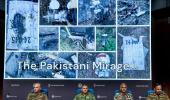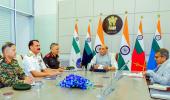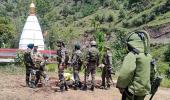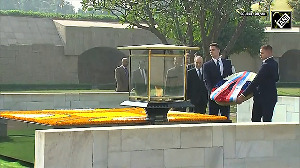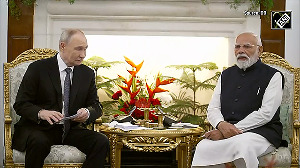'You can be sure that the Pakistanis knew when the Indian Air Force aircraft took off, which type these were, and what their likely targets were.'
'The question was: How would they determine that the IAF wanted to fire, and when to bounce them?', notes Shekhar Gupta.

Many analytical takeaways and lessons will emerge from Operation Sindoor in the course of time.
Who knows, if there are more episodes left in this story, and what the next might be.
For now, let's follow our familiar three-example rule and examine some standout points from the operation.
The first, of course, is how one secures surprise when the other side has been in a most heightened state of alert for 14 days, fully mobilised, assets airborne, missiles locked and loaded.
The second -- the optics, packaging and headline management for India's riskiest moment in a generation.
And third, the audacity it needed to take risks of this magnitude, to game the escalation ladder and tolerance/acceptance levels.
The most remarkable thing is the surprise.
With Uri and Pulwama, the Modi government had set up a template. Everybody in Pakistan -- and indeed in India -- knew the strikes were not a matter of whether but when.
There were many who said these retaliations must take place within 24 hours, if not immediately after the killings.
Or the Overton Window keeps shrinking. Why wait out for a full 14 days then?
You can be sure that the armed forces would have war-gamed this response.
There has been an element of inevitability to major terror attacks in India since the December 13, 2001 (Parliament attack).
There is one always around the corner. The forces did not need these 14 days to make fresh plans, or to acquire a new weapons system.
Why the long wait then?
The conjecture is that this was needed to take away that predictability.
The other side also saw the Overton Window shrinking and that contributed to the tiny few seconds, no more than 30 seconds of surprise becoming available.
You can be sure that the Pakistanis knew when the Indian Air Force aircraft took off, which type these were, and what their likely targets were.
You can also be sure that the Pakistan air force flew their best-equipped aircraft parallel to these on their side.
The question was: How would they determine that the IAF wanted to fire, and when to bounce them?
It was in that situation, when fully visible to the other side, your general intention pre-announced, that those seconds of surprise needed to be found.
Just enough to line up the target, shoot, and start the journey home. The fact is, the weapons were launched right under the eyes of the PAF.

The Modi government utilised these 14 days to build an impression that there was no hurry, that it might even follow the advice of many of its social media supporters to strangle Pakistan on a long rope, blocking them at the International Monetary Fund, reopening the Financial Action Task Force and keep squeezing them on the Indus rivers.
We can now see that even the 'action' on the waters was part of this grand deception.
That India would prefer the safer and slower approach of starving Pakistani farmers of water rather than risk an armed conflict.
Prime Minister Narendra Modi had big meetings on a daily basis, the Cabinet Committees, including the Cabinet Committee on Security.
There was one with the service chiefs, national security adviser and the raksha mantri, and then with the individual chiefs, NSA and defence secretary. All on camera.
One evening, the government let the word drop that a big announcement was coming. It was the caste census. An impression was created that the government was letting public anger dissipate.
The India-UK free-trade agreement was announced and celebrated. Modi went to the ABP News Summit and delivered his usual Viksit Bharat speech with just a mention of the Indus waters.
That again was a distraction, we can now see.

For the next day, a large air power exercise was scheduled in the Rajasthan sector.
A couple of other exercises had been held already, so this also seemed like buying time.
For the day after this, nationwide civil defence drills were called. Again, as if to drag things along.
Even on the night/early hours of May 6-7 as the fighters took off, Pakistanis must have tracked them in parallel.
It is probably the repetitiveness of such activities with no outcome that created those few seconds of surprise.
Whatever the Pakistani claims, those weapons hit their targets.
The optics and messaging, with the codename addressed to Indian women who were made to watch the men in their family killed by terrorists at Pahalgam, two women officers underlining the jointmanship of our forces and multiple diversities of our people.
The briefing was measured, minus the grandstanding or jingoism. Please note also how the social media handles on the Bharatiya Janata Party's Right 'rectified' their position on Himanshi Narwal and her secular liberalism.
There were even words of regret and advice to the comrades not to fall into the divisive trap.
In the briefing on Wednesday, May 7, 2025, Foreign Secretary Vikram Misri said the objective of the Pahalgam massacre last month was to trigger communal riots across India.

The third, the audacity. This was a risky move and, at the very least, it entailed possible casualties.
After Pulwama, the PAF knew for sure there would be an attack. The risk was failure, and finally, of an uncontrollable escalation, particularly if the bombing succeeded.
This is by far the riskiest action by Modi in more than a decade. Especially now with many ongoing wars, distractions, Russia war-weary. The Trump administration makes it more uncertain.
To sum up, while all of this is so far so good, the ball is now in Pakistan's court.
How they want to play, what they can do with it, and how prepared we are to counter them will script the next episode of this story.
By special arrangement with The Print
Feature Presentation: Aslam Hunani/Rediff.com


